Dutch Mail
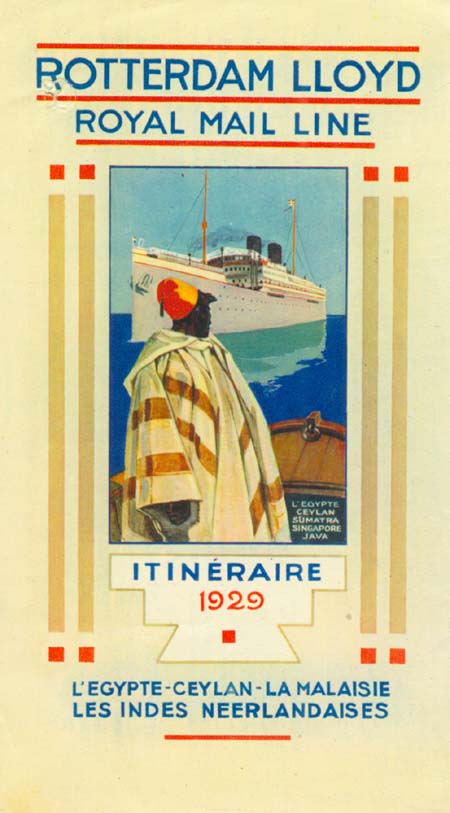 Rotterdam Lloyd ad 1929 (coll. WS)
Rotterdam Lloyd ad 1929 (coll. WS)
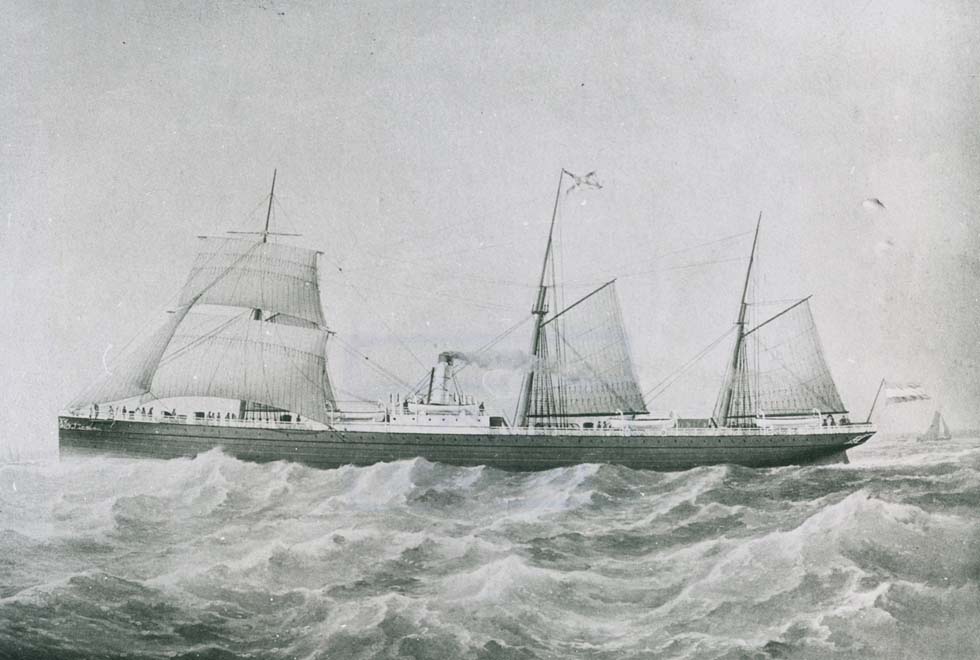
"Prins van Oranje", SM Nederland (Ned. Hist. Scheepvaart Museum)
The other colonial power in South-East Asia apart from England had been the Republic of the Netherlands. It retained Java, Sumatra and neighbouring islands, founded an own East India company in 1602, the Vereenigde Nederlandsche Geoctroyeerde Oostindische Compagnie, initiated mainly by Johan van Oldenbarnevelt. After in 1795 Napoleon conquered the Netherlands, the company was dissolved and the state took over. There was a temporary British rule and in 1816 the archipelagos became the colony Nederlandsch Indie of the Kingdom of the Netherlands.
Connection was kept only by sailing vessels, the so-called Indiaman. An attempt to establish a Nederlandsche Handel-Maatschappij for providing regular mail services was thwarted by Dutch ship-owners. In 1830 the steamer "Atlas" of the Nederlandsche Stoomboot Maatschappij was to undertake a voyage to East India, but on account of a too high coal consumption the voyage ended soon. Another attempt with the frigates "Utrecht", "s-Gravenhage" and "Nestor", equipped with auxiliary steam engines, failed in 1867. Also the Egyptian overland route was not the customary way for Dutch mails and passengers, as Th. M. Elsing of the Nederlandsch Scheepvaart Museum confirmed. The clippers sailing round the Cape maintained their dominance.
Only after opening of the Suez Canal there was a direct Dutch mail service to Java. The N.V.Stoomvaart Maatschappij 'Nederland' had been founded in 1870 for that purpose. Their first steamer was the "Willem III", departing in May 1870 from Den Helder, but the ship was lost already in the Channel after fire had broken out. In September 1870 their steamer "Prins van Oranje" (3,019 gt) arrived in Batavia on Java island.
An English enterprise participating in mail services between the Netherlands and East India was the Commercial Steamship Company (according to Dr. Hogesteeger: Naar de Gordel van Smaragd), starting with the steamer "Harrington". Another source mentioned a service Holland - Batavia by the Stoomvaart Maatschappij 'Java' with the steamer "Celebes" (2,265 gt).
Apart from the 'Nederland', the other important firm to enter the mail business between the Netherlands and Batavia via the Suez Canal was Ruys & Sons. Under the management of the entrepreneurs van Ulphen and Ruys they had sailed to Java already in 1844. In 1861, when steam supplemented sails, the firm was known as W. Ruys & Sons. In 1875 they opened a Netherlands - Java steamer service with the "Groningen" (2,500 gt). Ruys & Son became known in 1883 as the Rotterdamsche Lloyd, nevertheless the firm remained a family enterprise.
From 1887 the 'Nederland' and the 'Lloyd' sent one ship every other week, thus establishing a weekly service. In 1888 the 'Nederland' changed its port-of-call from Marseilles to Genoa. It was a result of the completion of the Gotthard railway in 1882, promoted by Germany in order to shorten the way to the Mediterranean.
At Batavia the new port of Tandjong Priok was built between 1872 and 1893. The city of Batavia together with neighbouring Weltevreden became later integrated into Jakarta, the vast economic centre of the country. It was reported that passengers still favoured occasionally foreign steamers and changed at Singapore on a connecting line. That gave obviously reason for the S.M. Nederland company to transfer the route from the west to the east coast of Sumatra with a call at Singapore. The Rotterdamsche Lloyd followed in 1925.
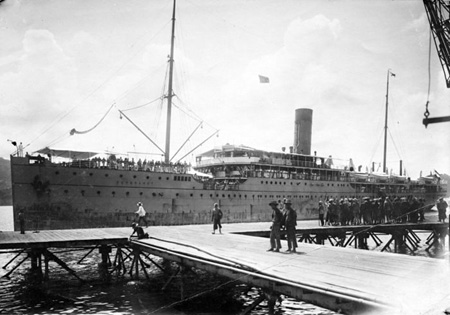 "Rembrandt" of 1906, S.M. Nederland, first arrival at Sabang, an island north of Sumatra (Tropenmuseum, via Wikimedia)
"Rembrandt" of 1906, S.M. Nederland, first arrival at Sabang, an island north of Sumatra (Tropenmuseum, via Wikimedia)
WWI and Aftermath
During World War I the mail steamers temporarily took the way via the Cape of Good Hope. From 1917, both the Nederland and the Rotterdamsche Lloyd took a route San Francisco - Java in connection with the overland railway through the USA. After the war the traditional Suez route was resumed. In 1925 the timetable showed a fortnightly S.M.Nederland service Rotterdam - Southampton - Algiers - Genoa - Port Said - Suez - Colombo - Sabang - Belawan - Deli - Singapore - Batavia, alternating with the Rotterdamsche Lloyd service Rotterdam - Southampton - Tangiers - Marseilles to Batavia with the same ports-of-call. After the recession, departures were only every three weeks.
Dutch mail from ordinary trains was taken aboard at Marseilles and Genoa, regulated already by a mail contract from 1893. For passengers of the Rotterdamsche Lloyd a connecting special express started for Marseilles in 1927. It was the Rotterdam Lloyd Rapide, from 1928 a regular service Den Haag - Paris - Marseilles under contract. The competitor's immediate response was the Nederland Express Amsterdam - Cologne - Genoa. Both trains included cars of the Wagons-Lits company CIWL. Also on the other end of the seaway the steamers connected with trains, from 1936 a new night-express to Soerabaya (Surabaja), waiting alongside the quay at Batavia Tanjungpriok.
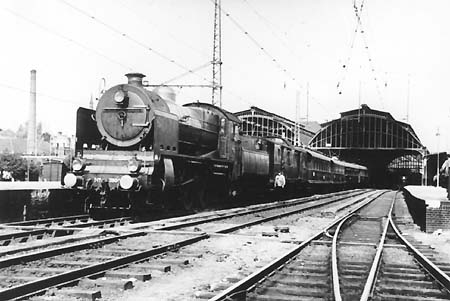
'Nederland Express', departure Den Haag, 1939 (coll. Rutgers van Rozenburg)
|
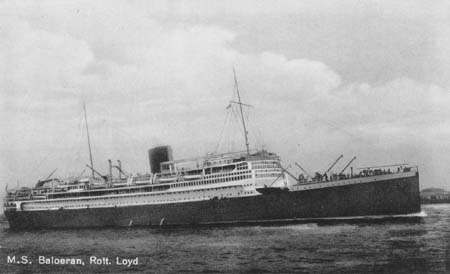
"Baloeran", Rotterdam Lloyd (old card, coll. WS)
|
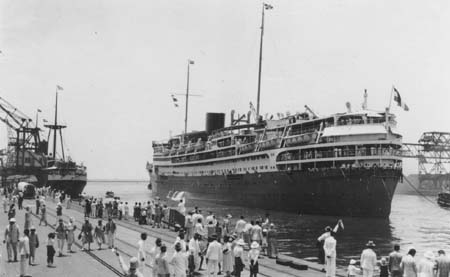
"Baloeran" leaving Batavia (old card, coll. WS)
|
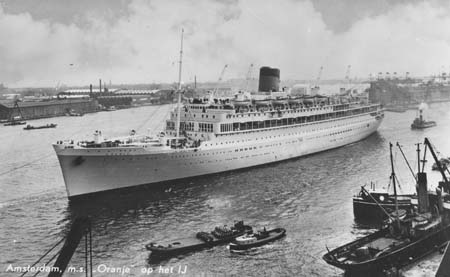
"Oranje" of 1939, S.M. Nederland (old card, coll. HSch)
|
After WWI the largest ship of the Rotterdamsche Lloyd had been the "Patria" (9,900 gt), until in 1924 the "Slamat" (11,404 gt) as the last steamer, and in 1925/27 the motor-ships "Indrapoera" (10,648 gt) and "Sibajak" (12,040 gt) were put in service. In 1930 the Rotterdam Lloyd attained a new dimension with the MS "Baloeran" (16,981 gt), followed in 1931 by the "Dempo". With their light-grey painted hull, white superstructure and dark funnel, being the company's trademark, they were used on the Rotterdam - Batavia main line prior to WWII, assisted by the "Sibajak" and the "Indrapoera".
The Nederland Line took delivery of five steamers of the K-class in 1911, beginning with the "Karimoen" (6,910 gt), for the East Asia service. Between the wars, the "J.P. Coen" (11,700 gt) and then the "Poelau" and the T-class followed. Rivalling with the Rotterdamsche Lloyd, the S.M. Nederland placed orders for the "Johan van Oldenbarneveld" and "Marnix van St. Aldegonde", each of 19,000 tons, put in service in 1930 on the Batavia route. Kept in black/white livery with two buff funnels, they were considered not as handsome as their competitors.
WWII and Aftermath
When Hitler started World War II in September 1939, the "Dempo" and the returning "Baloeran" met for the last time at Cape Town, avoiding the Suez route. For some time in 1940 the Nederland-Express and the Rotterdam Lloyd Rapide resumed service, now both bound for Genoa. In 1941 the Japanese occupied the Netherland Indies and New Guinea. Dutch mail services to Batavia restarted in 1946, but now insurgency began and in 1949 the archipelagos became the independent Republic of Indonesia.
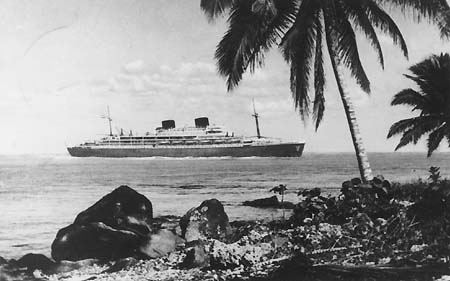
"Willem Ruys", Rotterdam Lloyd (old card, coll. WS)
|
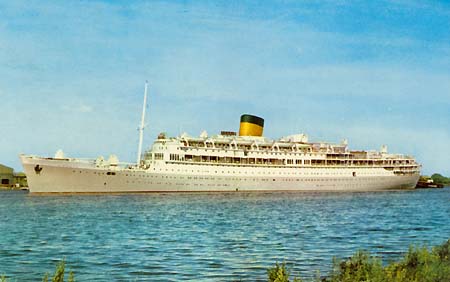
"Oranje", Nederland Line (old card, coll. WS)
|
For the Nederland Line the beautiful M.S. "Oranje" (20,565 ts, 21 1/2 knots) with one funnel, had been built in 1939. She re-opened the Amsterdam - Batavia service in July 1946. The counterpart of Rotterdam Lloyd, the MS "Willem Ruys" (21,119 ts, 22 knots), black/white with two black funnels, was completed not before 1947, delayed by war and resistance. In December 1947 she had the first departure for Batavia. Exactly ten years later, in 1957, the Koninklijke Rotterdamsche Lloyd and in 1958 the SM Nederland stopped the regular Indonesia services. They opened round-the-world routes from 1959. In 1964 the "Oranje" and "Willem Ruys" were sold to Achille Lauro of Italy.
In 1964 the Holland America Line opened a temporary round-the-world service Rotterdam - Australia - New Zealand - USA - Europe with the "Ryndam" (15,015 gt). After 1971 the famous company changed exclusively to cruises, thus maintaining Dutch pride on the oceans.
For the history of the Dutch West-Indies mail see Dr.G. Hogesteeger: Naar de Gordel van Smaragd. PTT Museum Den Haag.
See also www. trains-worldexpresses.com
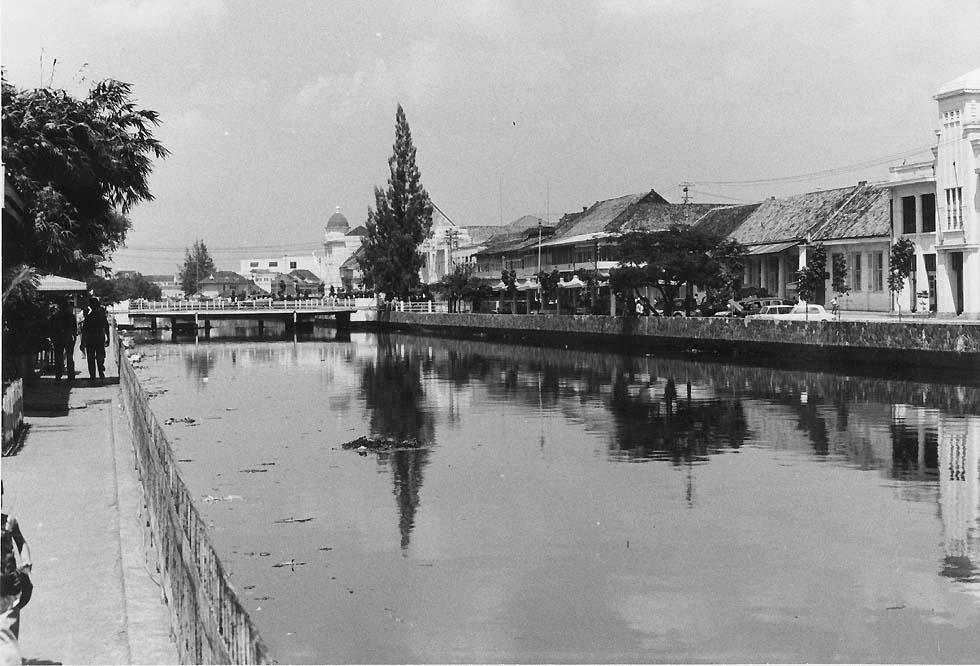
Jakarta, the old Batavia (WS)
|